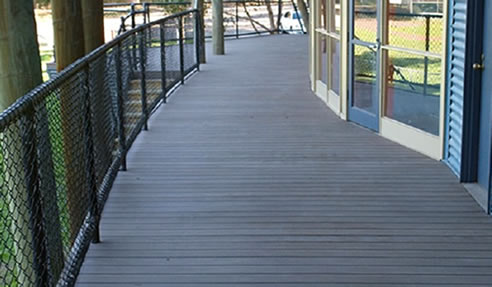The Evolution of Composite Wood by Futurewood

Composite Wood is a relatively new material compared to timber however, it's slowly but surely changing the game.
The production of composite wood products began in the USA in the 1980s, where natural timber was still the material of choice for all decking projects. However, timber decking, apart from aesthetics, does have many limitations. No matter how expensive the hardwood is, it can't save itself from rotting, warping, twisting, colour fading and termite attack.
Early composite wood products, namely hollow composite wood, unfortunately, cast a negative perception to all composite wood products. Hollow composite wood (Literally hollow on the inside) caused numerous problems. The vulnerable state of hollow composition made the planks prone to moisture absorption, later leading to the development of stress points and cracking, resulting in people falling through decks.
The misconceptions on composite wood could have been avoided through proper knowledge and handling techniques. Back in the day, the installation process of composite wood was treated in the same way as natural timber. For instance, composite timber roofing was screwed and nailed in place - the same process for corrugated iron alternatives. This occurrence resulted to unnecessary cracks where the screw or nails were placed and eventually ended with leakage. This nuisance was then addressed by developing a rather special screwing or fixing system.
With innovations in composite wood comes the ease of its installation process. Futurewood has adapted this technique and further developed it with their very own cladding system and fixtures, for an easy installation method. Quick fixing is applicable for composite wood decking, wood cladding and fencing. Each product has its own fixing guidelines and specifications that must be followed to avoid unnecessary damages.

Futurewood's composite wood products come with a 10-year warranty, provided that proper installation is done and damages incurred aren't caused by mishandling and erroneous installation. To avoid such mistakes and assist the clients in the installation process, Futurewood released a step-by-step installation and fixing guidelines for composite wood decking, wood cladding and fencing on their website and brochure.
With an increasing interest in the sustainable living environment, interior designers, architects and builders alike are shifting to composite timber for its many benefits. Composite wood has become the antidote for environmental, financial, functional and aesthetic problems.
Futurewood's composite wood products are made from recycled HDPE (Industrial waste and post-consumer plastic waste, WPCs), wood flour (Sawdust) and discarded rice husks. To make it more durable and long lasting, Futurewood combines it with UV inhibitors, anti-mould and mildew components and colour pigments. The process of producing composite wood requires little carbon emission.
The innovation of composite wood also addresses the following aspects:
- Low upkeep - Reduced need to polish, stain, oil, paint and lacquer the composite boards
- Saves time and money on maintenance
- Radiates the same aesthetic appeal of natural timber
- The cladding system and fixtures offer a non-intrusive screw that doesn't hamper the design of the wood board
- Termite and white ant resistant - No need to replace composite wood
- Moisture resistant
- Colours lasts longer than natural timber
- Composite wood is available in five designer colours: Mahogany, chocolate, Walnut, Slate Grey and Saltbush
- Clients get the upper hand in the design process by choosing the pattern, colour and texture that suits their requirements and specifications
The use of composite wood has been tried and tested to suit Australia's diverse environment. Considering the fact that Australians love the outdoors, bringing a piece of nature at home through composite wood decking, cladding or fencing is already an added luxury.
For installation inquiries and additional information on timber alternatives, contact Futurewood today.

|





 Facade Screening for Industrial
Facade Screening for Industrial Care Tips for Composite Timber Decking
Care Tips for Composite Timber Decking Composite Timber for Picnic Tables by
Composite Timber for Picnic Tables by Three Types of Decking by Futurewood
Three Types of Decking by Futurewood Weatherproof Cladding Supplier by
Weatherproof Cladding Supplier by Composite Timber Fences for Backyards by
Composite Timber Fences for Backyards by Composite Decking Frame by Futurewood
Composite Decking Frame by Futurewood Composite Decking Supplier NSW by
Composite Decking Supplier NSW by Composite Timber for Outdoor Benches by
Composite Timber for Outdoor Benches by Vertical Screening for Backyard by
Vertical Screening for Backyard by Weatherproof Composite Cladding for
Weatherproof Composite Cladding for Maintenance Free Decking by Futurewood
Maintenance Free Decking by Futurewood Timber Alternative Features by
Timber Alternative Features by Aluminium Subframe for Decks by
Aluminium Subframe for Decks by Advantages of EnviroSlat Screening
Advantages of EnviroSlat Screening Composite Timber Screen Fencing by
Composite Timber Screen Fencing by External Weatherproof Cladding by
External Weatherproof Cladding by Ultralow Aluminium Joist and Pedestal
Ultralow Aluminium Joist and Pedestal Advantages of Composite Decking
Advantages of Composite Decking How to Clean Composite Timber by
How to Clean Composite Timber by
